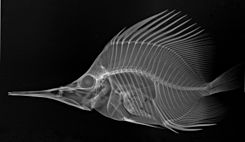Forcipiger longirostris
| Longnose butterflyfish | |
|---|---|

| |
| Scientific classification | |
| Kingdom: | |
| Phylum: | |
| Class: | |
| Order: | |
| Family: | |
| Genus: | |
| Species: | F. longirostris
|
| Binomial name | |
| Forcipiger longirostris (Broussonet, 1782)
| |

| |
| Longnose butterflyfish range.[1] | |
Forcipiger longirostris, commonly known as the longnose butterflyfish or big longnose butterflyfish,[2] is a species of butterflyfish found on coral reefs throughout the tropical waters of the Indo-Pacific.[3] Even with its distinctive, point-like long nose, the longnose butterflyfish still can easily be confused with its more common cousin F. flavissimus. Both species may be kept in aquariums.
Description
F. longirostris has a compressed yellow body with a black triangular region on its head, and as the name implies, a long, silvery snout. Usually 10 or 11 dorsal spines, a black spot on the anal fin, and rows of small black spots on the breast are found. The fish grows to about 22 cm (8.7 in) in length. In comparison, F. flavissimus has more dorsal spines, lacks the black spots, and its operculum is more curved.[4]
Rarely, F. longirostris can be found in an all-black form, as well,[5] or the yellow portion may be brown.[6]
Behavior
F. longirostris is a diurnal omnivore,[7] feeding mostly on small crustaceans, tube feet of echinoderms and sea urchins, and polychaete tentacles. Like other butterflyfish species, longnose butterflyfish mate for life.
Nomenclature
F. longirostris, together with F. flavissimus, is known for having the longest fish name in the Hawaiian language: lauwiliwilinukunukuʻoiʻoi,[8] or "long-snouted (sharp-beaked) fish shaped like a wiliwili leaf". It was the first Hawaiian fish to receive a scientific name, when Captain James Cook collected a specimen (this remains part of the British Museum collection).[5]
References
- ^ a b Myers, R. & Pratchett, M. (2010). Forcipiger longirostris. The IUCN Red List of Threatened Species doi:10.2305/IUCN.UK.2010-4.RLTS.T165667A6085300.en
- ^ Common names of Forcipiger longirostris. Fishbase.
- ^ Lieske & Myers,Coral reef fishes,Princeton University Press, 2009, ISBN 9780691089959
- ^ "Longnose Butterflyfish". Australian Museum. November 2004. Retrieved 2009-04-20.
- ^ a b "02 Year - Final Report" (PDF). University of Hawaii Cooperative National Park Resources Studies Unit. November 10, 1975. pp. 49–50.
- ^ Froese, Rainer; Pauly, Daniel (eds.) (2009). "Forcipiger longirostris" in FishBase. January 2009 version.
- ^ "QUEST - Fish Identification List" (Microsoft Word). Kalakaua Marine Education Center, University of Hawaii at Hilo. Retrieved 2009-04-20.
- ^ "Hawaiian Marine Communities". Waikiki Aquarium. Retrieved 2009-04-20.



